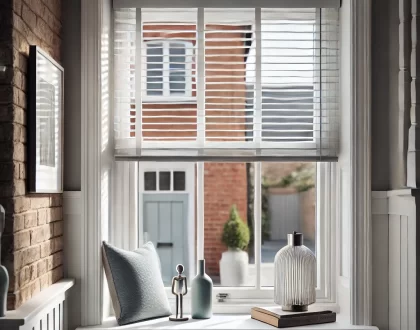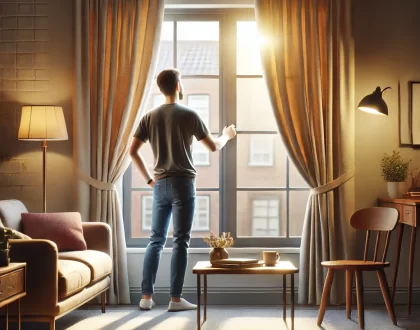Is Triple Glazing Worth It?

If your double-glazed windows aren’t doing their job, triple glazing is seen as the logical step up in terms of efficiency. But adding that third pane of glass into the mix makes it a step up in terms of the price too.
So, is triple glazing worth it? In this post, we’ll take a closer look at how triple glazing works, the benefits it offers and some potential alternatives to see whether it’s worth the investment.
How does triple glazing work?
Single glazing refers to windows with one pane of glass. Double glazing has two. And, you guessed it, triple glazing comprises three panes. Those glass panes are separated by two small air gaps, typically around 16mm in size.
In this respect, triple glazing shares the same basic principle with double glazing. The thin gap of air works as an additional barrier between the glass panes, making it more effective against heat loss and noise.
The crucial difference is that triple glazing comprises five layers in total – three panes of glass and two air gaps – compared to the three layers of double glazing. With that comes a range of alleged benefits…
Heat loss
One of the main reasons triple glazing is worth it, according to any salesperson, will be that it reduces heat loss. Having an extra pane of glass and an additional gap of air makes it harder for heat to pass through triple-glazed windows, which effectively makes them better at ‘keeping the cold out’.
In turn, this makes it easier to keep your home at a comfortable temperature, which reduces the need to turn on the heating as frequently or as high. That could lead to lower energy bills, saving you a significant amount of money over time.
Noise reduction
The more substantial structure of triple glazing also makes it ‘worth it’ when it comes to noise reduction. Above all else, this is simply down to it being thicker than a double-glazed window.
With three 4mm panes and two 16mm air gaps (as an estimate), triple-glazed units are approximately 44mm in size. That provides a more significant barrier for sound waves to pass through, although it’s not the most effective way to minimise noise in your home – more on that later.
Condensation
Many articles explaining why triple glazing is worth it will list its ability to stop condensation. However, that isn’t entirely true.
With more panes and gaps separating the exterior and interior surfaces of your window, there’s less chance of the inside of the window becoming cold and attracting moisture from humid air. But that doesn’t account for the other kind of condensation which affects the inside of double-glazed (and triple-glazed) windows.
Triple glazing stops condensation building up inside your windows because you will have a new unit installed which has just been sealed. However, it’s still prone to those seals breaking down over time. Once they do, you’ll be left with the same misty-window problem.
Security
More panes of glass and a bigger barrier are harder to break through. It’s that simple. If burglars are tasked with breaking a single-glazed window, they’ll do so in an instant. Double-glazed might take a little longer. Triple glazing will take some real force to get through and, at the very least, make it harder for criminals to enter your property discreetly.
But is triple glazing worth it?
Whether or not triple glazing is worth it comes down to how well it delivers on its promises. If it keeps heat in, reduces noise, eliminates condensation and improves security, then it’s absolutely worth the cost.
However, as touched upon above, triple glazing is not the best solution when it comes to reducing noise and eliminating condensation. On top of that, it’s not suitable for heritage properties or those that want to retain their character.
Thankfully, triple glazing isn’t the only option available. Secondary glazing is a high-performance option that provides many of the same benefits – and exceeds triple-glazed windows in several ways.
How does secondary glazing compare to triple glazing?
While triple glazing is essentially a replacement for your single- or double-glazed windows, secondary glazing doesn’t affect the existing window in any way. Instead, it’s installed on the interior recess of the primary window in a way that’s discreet and almost unnoticeable even from the inside of the property.
Like triple-glazing, secondary glazing adds an extra pane of glass and an additional gap of air to the structure of your windows. It does so with a fully sealed, secondary unit, meaning the gap of air is actually larger than it would be with triple glazing.
First of all, this additional layer will increase your windows’ thermal efficiency. Much the same as triple-glazed windows, secondary glazing makes it harder for warm air to escape, which can improve heat retention by 60-70%.
But here’s where it gets better. Because the gap between the primary and secondary window is bigger than the gap on existing double-glazed windows, secondary glazing creates a non-uniform structure which makes it harder for sound waves to pass through. With greater dissipation of sound waves, you could see noise reduced up to five times more effectively than triple glazing.
It also eliminates condensation in a way which triple glazing can’t. By completely sealing off your existing windows, secondary glazing can minimise condensation inside your double-glazed unit.
That’s all topped off with increased security from a robust, secondary window. While triple glazing is the most robust option for one window, secondary glazing essentially means thieves have to break through two windows to get into your property.
Secondary glazing that’s completely worth it
Whether or not triple glazing is worth it comes down to what you want for your property. If your main interest is heat retention and you’re happy to replace your windows, it’s probably a good fit. However, if you’re looking for high performance across the board without impacting your existing windows, secondary glazing is the best option for you.
At Clearview, we provide state-of-the-art secondary glazing solutions for customers across the UK. Our DIY secondary glazing kits give you everything you need to transform any kind of existing window. Alternatively, we offer professional installation within 50 miles of our head office in Sheffield.

 10 Year Guarantee
10 Year Guarantee 5 Star Customer Reviews
5 Star Customer Reviews

